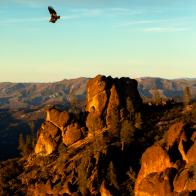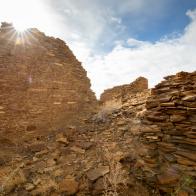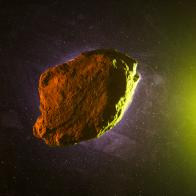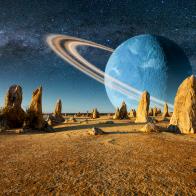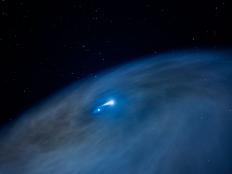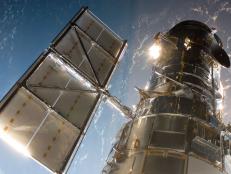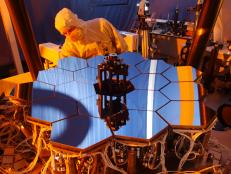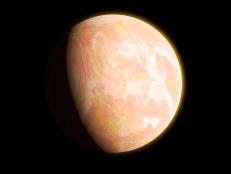SPACE OUT with Paul M. Sutter
Paul M. Sutter
All SPACE OUT Articles
Showing 1 - 15 of 153 results
How to Save Humanity from Extinction
Here are some goals we need to achieve if we want to reach our 500,000th birthday as a species.
Asteroid Ryugu Has Dust Grains Older Than the Sun. How?
In 2018 the Japanese space agency sent the Hayabusa2 mission to the asteroid Ryugu, As a part of that mission, the spacecraft blasted material off the surface of the asteroid, put it in a bottle, and sent it back to Earth. Two years later that sample landed in the western deserts of Australia.
When We’ll Know if NASA’s Asteroid Impact Test was a Success
Recently NASA’s DART mission succeeded in its primary goal, which was to slam a spacecraft face-first into an asteroid. For science. The intention of the mission was to test if we could actually redirect an asteroid and send it into a different orbit. But how and when will we know if it worked?
What Comes After the Moon and Mars?
Space hotels may be in our future.
What Screaming Black Holes are Telling Us
In 2002, NASA’s orbiting X-ray observatory, the Chandra telescope, mapped out the movements of hot gas in a cluster of galaxies sitting 250 million light-years away.
Want to Name a Planet? Now’s Your Chance
Read on to learn about this rare opportunity to name a distant world observed by the James Webb Telescope.
What We Learn from the Lunar Surface
Sure, the Moon is cool to look at, and fun to think about it. And it literally affects us here on the Earth: without the Moon, we’d be missing half our tides, and likely our planet’s rotation wouldn’t be as stable as it is.
Six Planets are Retrograde, What Does that Mean for You?
Spoiler alert: It's an optical illusion.
Got You! Astronomers Find an Especially Sneaky Black Hole
Black holes are tricky creatures. Since ancient times the practice of astronomy has been to point our eyes and instruments at all the glowing things in the skies above us. But black holes are defined by the fact that nothing, not even light, can escape their gravitational clutches. So how you do see something that is completely, totally black?
Why Astronomers Care About Super-Old Galaxies?
A long time ago, our universe was dark.It was just 380,000 years after the big bang. Up until that age, our entire observable cosmos was less than a millionth of its present size. All the material in the universe was compressed into that tiny volume, forcing it to heat up and become a plasma. But as the universe expanded and cooled, eventually the plasma changed into a neutral gas as the first atoms formed.
Here Comes Artemis I (Rescheduled, again)
NASA's long-awaited Artemis 1 uncrewed moon mission and next generation of spacecraft has been delayed for a second time. The rocket was initially scheduled to launch on Aug. 29, 2022, at 8:33 AM ET, but was delayed due to an issue with the engine bleed. Watch Space Launch Live: Artemis-1 on Science Channel to see the moment of liftoff. (Launch Date Pending) (Updated Sept 7, 11:00AM)
This Year, James Webb will Take a Close Look at a Lava World
The James Webb Space Telescope is gearing up to be an exoplanet extraordinaire. Among many other missions and targets, astronomers plan to use the observatory, now in its final stages of preparations to study…well, a world where it might rain lava.
How Astronomers Use a Trick of Gravity to See the Most Distant Objects in the Universe
Let’s say you’re an astronomer (work with me here) and you want to take a picture of something incredibly, deeply far away. You know, the typical business of astronomy.
What We’ve Already Learned From James Webb? (Hint: it’s a lot)
That was worth the wait. Just a quick handful of months since its historic launch on Christmas Day, the James Webb Space Telescope has flown to its observing position, unfolded its delicate instruments and ultra-sized mirror, and run through a suite of checks and alignments and calibrations. The team at NASA behind the telescopes released their first batch of images from the science runs, and besides being gorgeous, they're powerful.
How Exoplanets Became the Next Big Thing in Astronomy
To date, we know of over 5,000 planets outside the solar system. And astronomers suspect that there may be *checks notes* around a trillion more in our galaxy alone. The search for exoplanets is one of the hottest topics in astronomy, with expensive telescopes and giant collaborations all searching for the holy grail of the 21st century: an Earth 2.0, a habitable world like our own.




























